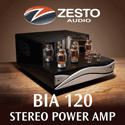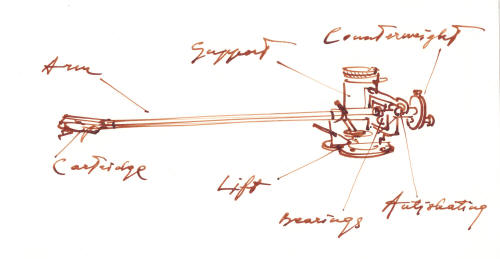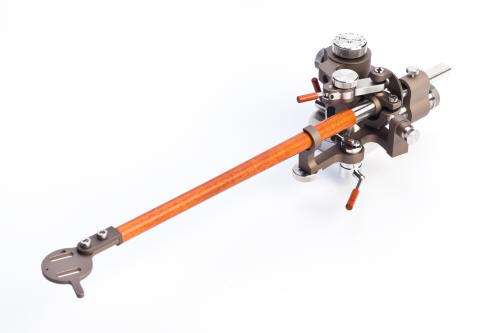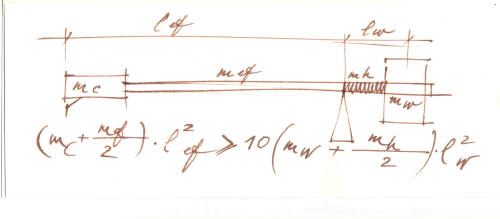|
|
You are reading the older HTML site
Positive Feedback ISSUE 72
reed 3P Tonearm as reviewed by Marshall Nack
a Day in the Life Here we are ensconced on the couch, listening to a little gem I came across recently with knockout sound, Ella Swings Lightly (Verve, MG VS-64021). This release won Ella the 1960 Grammy award for "Best Jazz Performance, Soloist." It's as good as her well-known Clap Hands LP.
My buddy George can't help himself and enthusiastically exclaims: "This is it! It's not gonna get much better than what I'm hearing now." This was Rig #1, consisting of the Brinkmann Oasis with 10.0 arm and an Air Tight PC1s cartridge. It was a collection of perfectly balanced superlatives—very even, accurate, with a slight bit of warmth and sweetness; it is silky smooth, yet resolving as heck. And then we move over to Rig #2…and it does. We note a bit of looseness in the bass, but wow! Ella's crooning is definitely reaching a higher orbit. George gushes, "This is it! This is what it would have sounded like in the studio." We ricocheted from superb to stupendous. Rig #2 was the Dr. Feickert Firebird table, Shelter Harmony cartridge and the item under evaluation: the Reed 3P tonearm. This rig is a stunner. It is not smooth, it has edges and texture—those tasty little bits that add zest and get your toe a-tapping.
Ah, life is good! I find myself in the enviable—some jealous souls might even say decadent—position of having two first-class analog rigs on my racks. What a treat! What was it that we all heard in Ella's voice/image that caught the ear and made us sit bolt upright? Ah, these ephemera are so difficult to put into words. Some Form of Palpability "It is alive, Master." Yes, Igor, so it seemed. Ella imaged in an air pocket at the front of the stage, separate from the rest of the band. This self-contained air capsule had reverb and decay characteristics, and a dynamic life of its own, wholly independent from the rest of the band. The Franken-image was wonderfully developed, crammed with intimate details. It was so complete and animated, it made you reflect on all of the stuff missing in the usual audio playback. Your mind was freed from filling in the gaps and, if you're a true-blue audiophile like me, was tickled pink and thoroughly entertained. However, the brass instruments in the band were not in air capsules, only Ella. Those instruments imaged conventionally, on either side and behind her. And they lacked the animation of the Franken-object. What I'm describing bore some resemblance to the way low-powered SET amps do female vocals. Palpability is a factor, but it was not as if Ella's image had that SET "reach out and touch me" tangibility. She is certainly spot miked, and maybe she is in a sound isolation booth as well. Regardless, this air capsule effect wasn't there before; it appeared when the Reed was installed on the Firebird. Multitasking When I think of Ella, I'm reminded of Pops. Let's listen to Louis Armstrong & Duke Ellington (MFSL 2-155). On this recording the instruments range across the stage and all of them are encapsulated. At any given time a variety of simultaneous improvisations are going on. With each solo bow, a capsule moves forward and the instrument within has that enhanced vitality.
Please turn up the volume. Noise byproducts and artifacts remain at low level and sound quality stays intact, but the Reed grows the signal and the illusion gains force—the air capsule effect becomes more pronounced. The Reed did this trick even with mono recordings. Now, there is no doubt about the artifactual nature of this Franken-image, but, man-o-man, it is powerful audio magic. The Rest of the Report Card As for the loose bottom I referred to at the beginning of this narrative, that occurred when the Reed had ~110 hours on it. There was also a slight dip in the lower midrange. It needed a full seven days, after which I played with VTA and loading. Both issues went away once everything was dialed in. Furthermore, the bass was now well-represented and powerful, with lots of flesh everywhere. The treble is beautifully nuanced and extended. Timbres were quite satisfying. Resolution matched the high-resolving Brinkmann and soundstaging is equally expansive and dimensional. Dynamics are also on par. Fun to Listen to With the report card out of the way, we come back to the salient point: the Reed is simply fun to listen to. There are several reasons for this. First, the Feickert/Reed does not present a smooth surface, it has edges and texture. This gives the listener more to "chew on," as a composer acquaintance once described it. Audiophiles, especially analog devotees, like to talk about musical flow. The Reed has it in spades. It is expert at delivering a fluid, mobile musical line. The wonderful thing about Ella and Louis is they are never static or lifeless. The same source played through the Brinkmann doesn't have the nooks and crannies, or the same nimble musical line.
The Wood Effect The second reason for the Reed's engaging quality is the wooden armtube. The manufacturer believes strongly that wood is the best armtube material and has posted laboratory test results and a white paper to support it. That doc concludes, "… (the) results of our test are basically same to some audiophile opinion, that tonearms with Red Cedar and Pernambucco wands produce very clean, transparent and deep sound." In his opinion, these are the best sounding woods and the best armtube material—period.
I can see many audiophiles running for the exits. A wooden armtube? Doesn't wood drift with time, temperature and humidity changes? The answer is a qualified yes. According to the importer, that is often the case because the wood has not been properly cured. Reed is meticulous on this point giving their woods the requisite two to three years to properly dry. Over the audition period of several months, I didn't detect any variation. However, I did detect a woody coloration, which is audible as warmth and the natural harmonics of tone woods. The effect is similar to that imparted by the maple and walnut footers, cable risers, shelving, etc., that I use all around my listening room and gives the Reed a colorful, classically analogue sound. Because of this, I hesitate to call the Reed 3P strictly neutral, if by neutral you mean uninflected. A Statement of my Biases IMHO, deviating from neutral with the tone woods is a positive thing—I'd go so far as to say, a desired thing, used in moderation. Live music has plenty of color. Neutral has become a flashpoint in today's politically-correct environment and, like most things PC, it has become detached from what people really hear and think. When reviewers feel compelled to say a component is neutral, even if they're reviewing a SET amp, the term has lost its meaning. The DFA Arm I certainly didn't think of the Dr. Feickert tables in these terms before the Reed. I know them quite well, having first reviewed the Blackbird in 2011, succeeded by the Firebird in 2012. One or the other has been in my house for years. They are superb tables in all regards except they sounded over-damped. I suspected the DFA arm that came with them was the cause, but I had no proof. It was obviously out-classed, but when I made inquiries, I was told the arm was not a weak contender. Therefore, I concluded the tables were responsible. Now, along comes the Reed and, I'm telling you, the Firebird is singing. It's so open and energetic—heck, it doesn't even sound like electronics. Notes lift off and float about the stage, in the air, buoyant.
Bottom line: what had been a front-end with a significant performance issue is now infectiously engaging. As my panel-mate Sheldon described it, "The Reed 3P makes music fun to listen to." Options There is no such thing as the standard model 3P. You get to choose from a rainbow of options, including:
My sample was configured with a 12" Pernambuco armtube, cryo copper wire, and Eichmann Bullet Plugs.
Cosmetics The 3P is a beautifully crafted object, the winner of several European design competitions. At this MSRP, you expect fit-n-finish to be highest quality and the 3P delivers. The level of craftsmanship is superior. Installation For this review, the system included the superb Vitus SP-102 and van den Hul The Grail SB phono stages, and the Veloce LS-1 or Trinity preamps. The Shelter Harmony cartridge was used throughout. I also had use of the HB Acrylic Power Distributor. Nifty Design Features The Reed 3P is chock full of innovative engineering and the user interface is both convenient and easily adjustable. The major features of the 3P are: Magnetic antiskating Opposing magnets are used in the anti-skating mechanism. As you make adjustments, it brings the magnets closer or further apart, exerting more or less pull. This can be manipulated on-the-fly, that is, while playing a record. Fine VTA adjustment There's a knob on top of the arm tower for fine VTA adjustment. Below it and on the side is a coarse VTA adjuster. Both of these can be manipulated on the fly. (I was informed that most arms supporting on-the-fly VTA generally weigh a ton, with bulky and heavy mechanisms. This prevents them from being used with suspended tables. Not an issue for the 3P, whose mechanism is comparatively lightweight. It will not knock turntable suspensions out of alignment.) Azimuth adjustment Right where the pivot point is on the arm, there's a lever for fine azimuth adjustment. Only Reed allows on-the-fly azimuth adjustment. Innovative bearing system – a mix of gimbal and unipivot principles The 3P has a yoke, which makes it a gimbal, but it acts like a unipivot. There are three pivot points on the yoke. One is in the center and this is the primary pivot point. It is the contact point for horizontal movement. There are two pivot points on either side of the yoke which control vertical movement. Magnetic stabilizers are used on both vertical and horizontal axis. The resulting bearing system is as rigid as a gimbal, but its friction coefficient is as low as in unipivot. Conclusion It was a perplexing state of affairs. Going into this review, I thought I had the Dr. Feickert Firebird turntable's sound nailed, having lived with it for the last two years (and prior to that the Blackbird model). I must confess: I was never 100% taken with the Firebird / DFA arm package. It did everything at the highest level except that it felt overdamped, a little suppressed. It did not allow music to lift off. Now along comes the Reed 3P tonearm as a replacement for the DFA and I don't recognize the sound of this front-end anymore. This arm brought a characteristic sound that is extrovertedly analogue. It is not neutral, as the term is commonly used today to mean uninflected and colorless. The Reed is colorful in the best sense of the word, just as live music is. And it does the audiophile dog and pony show as well as the best of them. The Firebird was transformed. The Reed 3P tonearm mated with the Dr. Feickert table is a gem. I enjoyed this front-end immensely. The only question I'm left pondering as I finish this review is: How would the Reed fare when mounted on other tables? Marshall Nack
3P Tonearm as configured Distributor
Avatar Acoustics
|













